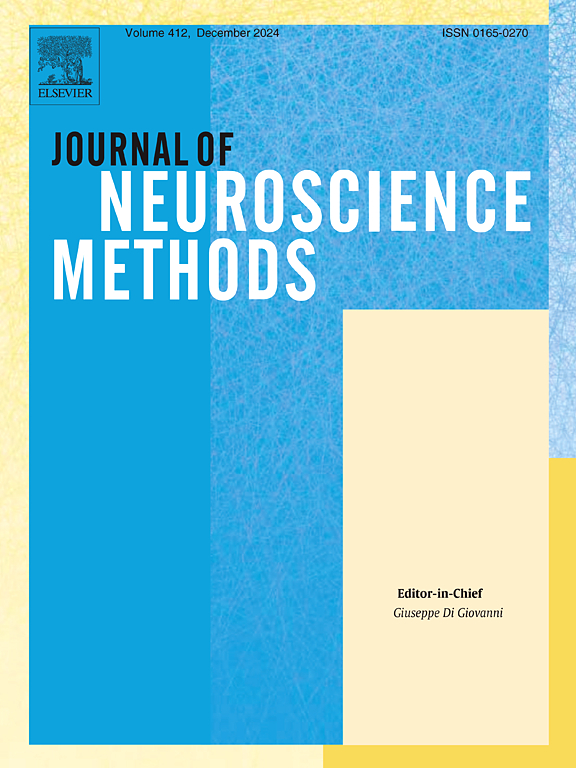Magnetic resonance imaging cerebral blood perfusion measurement in awake mice
IF 2.3
4区 医学
Q2 BIOCHEMICAL RESEARCH METHODS
引用次数: 0
Abstract
Background
Cerebral blood perfusion (CBP) plays a vital role in delivering oxygen and essential nutrients to support neuronal activity. Researchers commonly use mouse models with magnetic resonance imaging (MRI) to study CBP and brain function. However, a major challenge in these studies is the use of anesthesia, which significantly alters cerebrovascular dynamics and metabolic activity.
New method
A 3D-printed, custom-designed frame and head mounting plate were used with an existing Bruker mouse cradle. To evaluate the repeatability of CBP measurements in awake versus anesthetized conditions, we used a flow-sensitive alternating inversion recovery (FAIR) sequence on a wild-type mouse that underwent a three-day training before scanning to acclimate it to the MRI environment.
Results
CBP was significantly higher under anesthesia than in the awake condition for both the whole brain and cortex (P < 0.001). Under anesthesia, the mean perfusion for was 70.9 ± 5.6 ml/min/100 g for the whole brain and 67.8 ± 8.5 ml/min/100 g for just the cortex. Under awake conditions, the whole brain perfusion was 51.1 ± 3.3 ml/min/100 g and 46.7 ± 3.4 ml/min/100 g for the cortex. Perfusion variability, measured by variance and standard deviation, was consistently higher under anesthesia.
Comparison with existing methods
We built a unique mouse head stabilizing system for MRI and are the first to have specifically focused on CBP during awake conditions.
Conclusions
Our findings confirm that anesthesia significantly increases CBP, affecting the accuracy, reproducibility and relevance of perfusion-related studies. Accordingly, we developed a practical, MRI-compatible setup for imaging awake mice and used it to measure perfusion for more reliable neuroimaging research.
清醒小鼠脑血流灌注的磁共振成像测定
脑血流灌注(CBP)在输送氧气和必需营养物质以支持神经元活动方面起着至关重要的作用。研究人员通常使用带有磁共振成像(MRI)的小鼠模型来研究CBP和脑功能。然而,这些研究的一个主要挑战是麻醉的使用,麻醉会显著改变脑血管动力学和代谢活动。3d打印,定制设计的框架和头部安装板与现有的布鲁克鼠标支架一起使用。为了评估清醒状态与麻醉状态下CBP测量的可重复性,我们对一只野生型小鼠进行了血流敏感交替倒置恢复(FAIR)序列,该小鼠在扫描前接受了三天的训练,以使其适应MRI环境。结果麻醉状态下全脑和皮质scbp均显著高于清醒状态(P <; 0.001)。麻醉下全脑平均灌注量为70.9 ± 5.6 ml/min/100 g,皮质平均灌注量为67.8 ± 8.5 ml/min/100 g。在清醒状态下,全脑灌注为51.1 ± 3.3 ml/min/100 g,皮质为46.7 ± 3.4 ml/min/100 g。通过方差和标准差测量的灌注变异性在麻醉下始终较高。与现有方法的比较我们建立了一个独特的用于MRI的小鼠头部稳定系统,并且是第一个专门关注清醒状态下CBP的系统。结论麻醉可显著增加CBP,影响灌注相关研究的准确性、可重复性和相关性。因此,我们开发了一种实用的、mri兼容的装置,用于对清醒小鼠进行成像,并使用它来测量灌注,以进行更可靠的神经成像研究。
本文章由计算机程序翻译,如有差异,请以英文原文为准。
求助全文
约1分钟内获得全文
求助全文
来源期刊

Journal of Neuroscience Methods
医学-神经科学
CiteScore
7.10
自引率
3.30%
发文量
226
审稿时长
52 days
期刊介绍:
The Journal of Neuroscience Methods publishes papers that describe new methods that are specifically for neuroscience research conducted in invertebrates, vertebrates or in man. Major methodological improvements or important refinements of established neuroscience methods are also considered for publication. The Journal''s Scope includes all aspects of contemporary neuroscience research, including anatomical, behavioural, biochemical, cellular, computational, molecular, invasive and non-invasive imaging, optogenetic, and physiological research investigations.
 求助内容:
求助内容: 应助结果提醒方式:
应助结果提醒方式:


